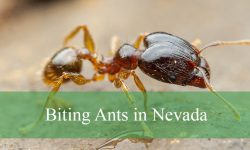With their eye-catching hues and dramatic contrast, red and black butterfly species liven up a variety of environments all over the world. From the temperate woodlands of North America to the deep rainforests of Central and South America, these exquisite insects captivate the attention of ardent devotees and casual onlookers alike with their exquisite beauty and symbolic meaning.
Different Red and Black Butterfly Species
Banded Lady
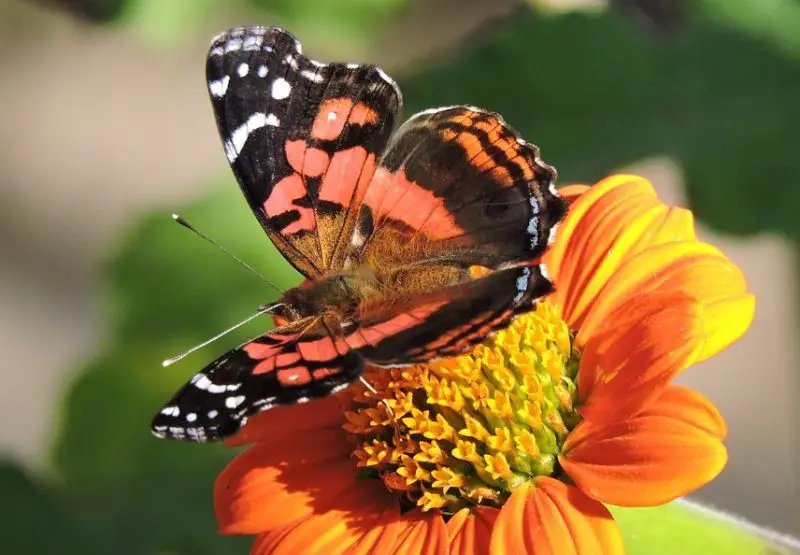
Vanessa Myrinna, often known as the Banded Lady, has a remarkable black and red pattern with noticeable eyespots. The dorsal wings are primarily red, turning black along the edges where black dots and patterns are present.
Brown body with white markings on the edges of the upper wings. Brown with gray and white bands are displayed on the ventral side, along with sizable blue eyespots to deter or distract predators.
Anchises Cattleheart
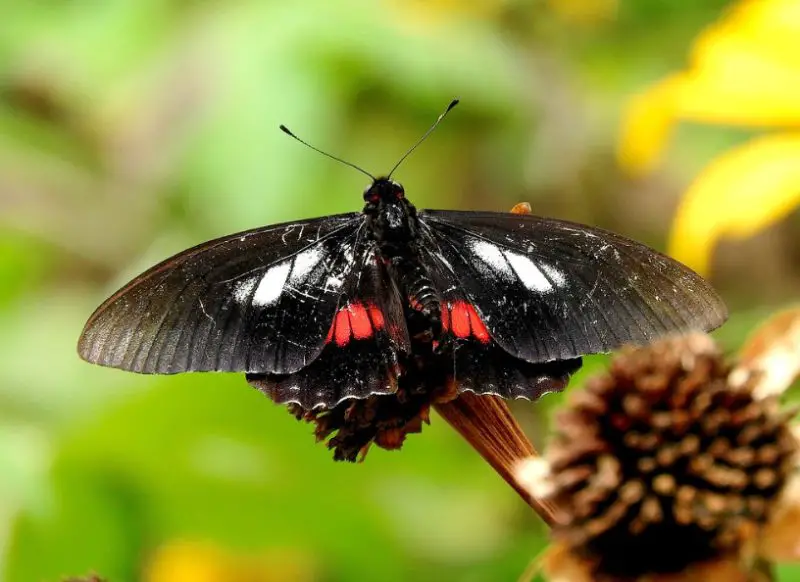
Native to North America, the Anchises Cattleheart (Parides anchises) feeds on plants in the pipevine family. Their wings are primarily black, with vibrant center patches on the top and lower portions. The middle regions of the hindwings are red or pink, whereas the parts of the forewings are white and gray. The ventral wings are brown in color, with brown, pink, or white center spots.
Doris Longwing
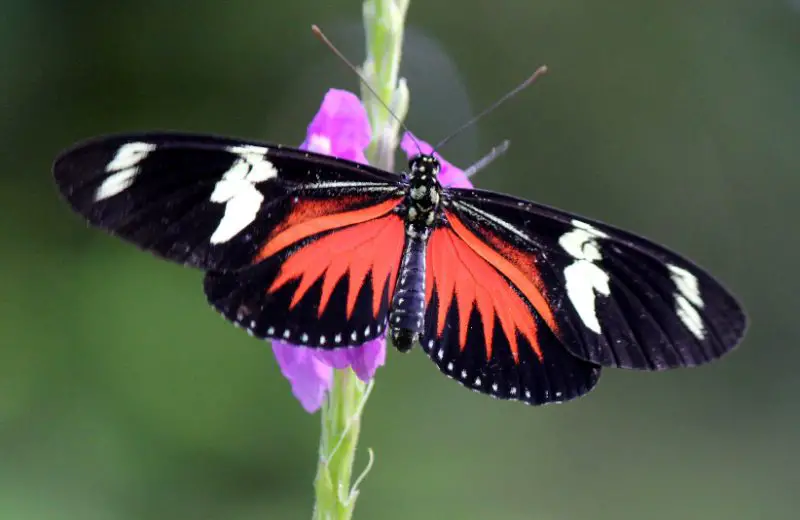
Doris Longwing butterflies use mimicry to their advantage by imitating other species and being imitated in return. Defense mechanisms are borrowed by this interdependent activity. Interestingly, Doris Longwings have an unpleasant taste that keeps predators away.
They can survive in an interspecies protective network thanks to their mimicry.
Pink-Spotted Swallowtail
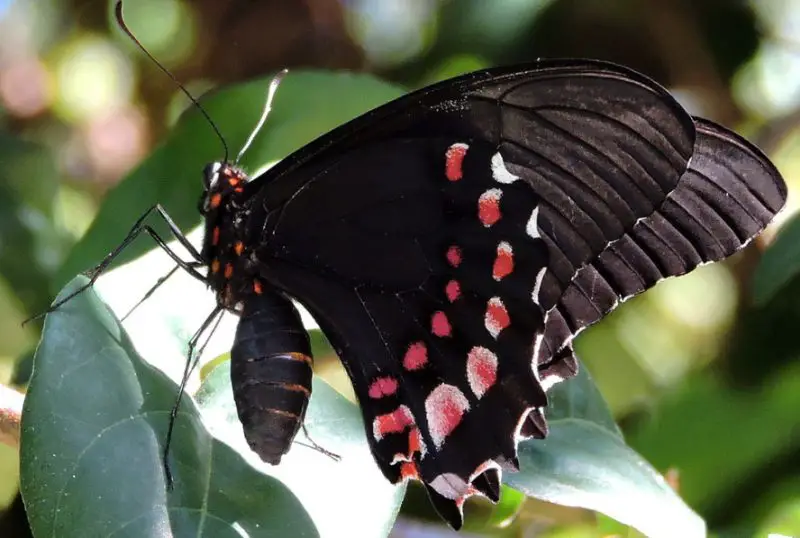
The pink-spotted swallowtail (Papilio rogeri) is distinguished by the pink-red dots on its black wings. The hindwings have rows of pink to red dots with black tail-like edges, while the forewings are still completely black.
The largest black butterfly in the United States, they live in the extreme south of Texas and are drawn to rue blossoms among other citrus flowers.
Red Peacock
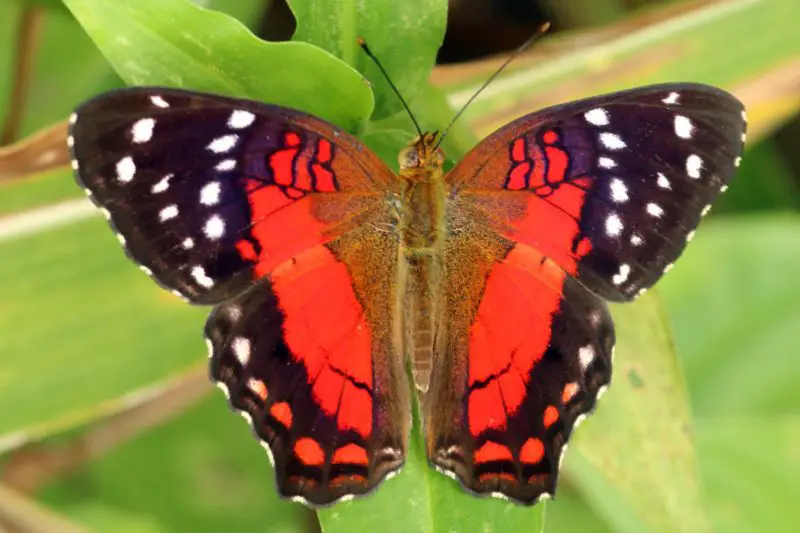
Although they are mostly prevalent in South America, red peacocks (Anartia amathea) can infrequently be seen in North America. These large butterflies are often found on tropical herbs such as sage. Easily identified by their vivid red color and black wings, which flow inward from the edges into the body.
Red dots draw attention to the hindwing margins, while white dots decorate the upper margins. Their bodies are reddish-brown in color, and their ventral wings are uniformly brown in hue.
New Zealand Red Admiral

With a wingspan of up to 50mm, the New Zealand Red Admiral, also known as Vanessa gonerilla, is a medium-sized butterfly. Its dorsal wings have crimson borders and prominent black and red colors, while its ventral wings are a brown camouflage with eyespots.
The upper forewings are emphasized by white markings, and the wings show a gradient from brown to black at the body to pure black at the edges.
Crimson Rose
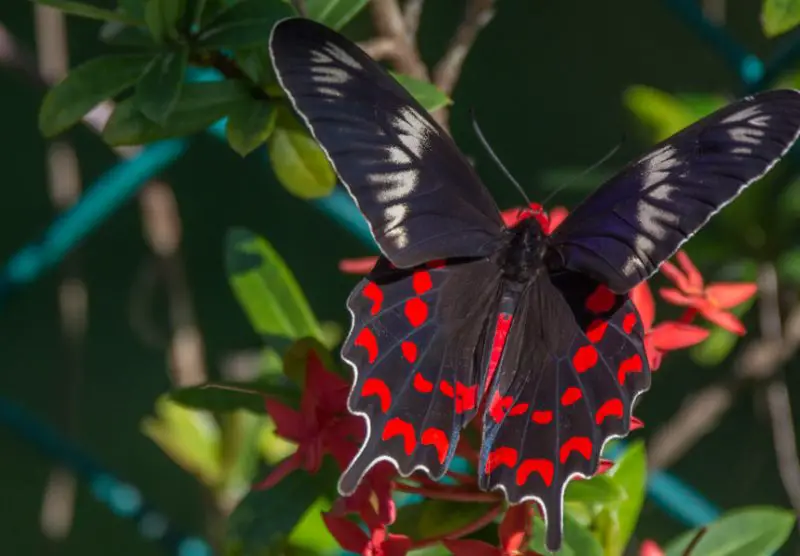
One famous black and red butterfly is the Crimson Rose (Pachliopta hector), which is found throughout Southeast Asia and India. With tail-like hindwings, it has a predominantly black coloring with white bands and red markings on its wings.
They consume pipevines while they are caterpillars, absorbing toxins as a defense. Adults taste awful, which keeps predators away. All year long, they live at low elevations, only rising to higher heights during the rainy season.
Imperial Jezebel
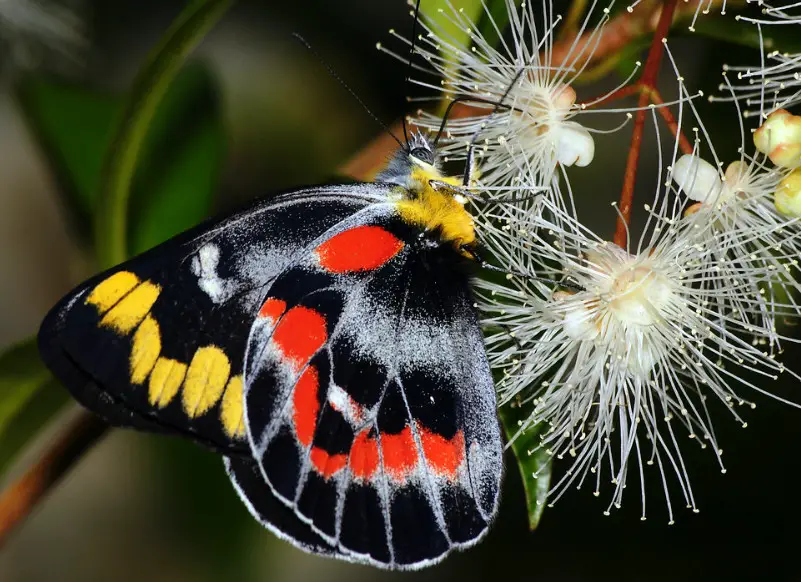
Naturally occurring in Australia, the Imperial Jezebel (Delias harpalyce) prefers environments with lots of eucalyptus. Its ventral wings, which are marked with yellow, have a startling black and red contrast to their white dorsal wings with black edges.
Their wingspans range from 60 to 70 mm, making them medium to large-sized birds distinguished by their striking black, red, and white patterning.
Natal Acraea
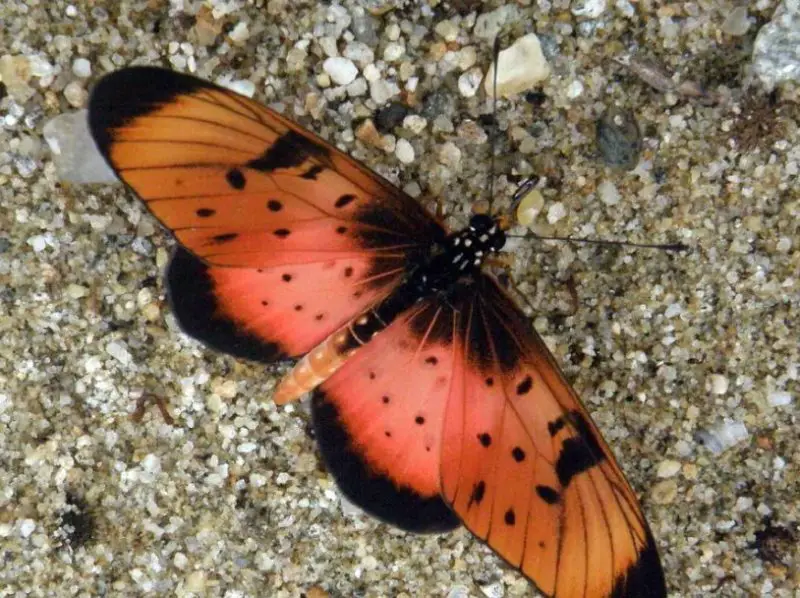
Only found in Africa, natalal acraea butterflies (Acraea natalica) are especially common in Zimbabwe. Their red to yellow base color makes them stand out. They are frequently seen on Passiflora plants.
The wings have red undertones that fade to yellow, with brown areas close to the body and the edges of the wings. The body is mostly brown to black, with similar hues on the hindwings with brown borders.
Pink-Spotted Cattleheart

A common black and red butterfly, the Pink-spotted Cattleheart (Parides photinus) has similar-colored dorsal and ventral wings. The hindwings are partially covered with white and have black upper wings with red markings on them.
They are mostly found in Central America, where they live at altitudes of several thousand feet.
Cloud-Forest King
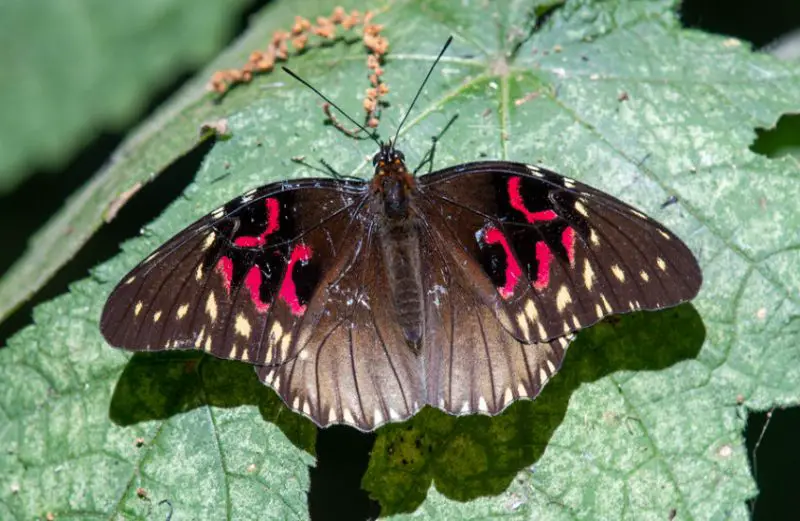
Native to Central America, especially Mexico and Panama, the Cloud-Forest King (Anetia thirza) has mostly black wings with colorful splotches. The forewings have red markings, and the hindwings and their margins have yellow specks, while the top wings are primarily black with brown edges. Visible veins and dark brown tones enhance its variegated appeal.
White-Dotted Cattleheart
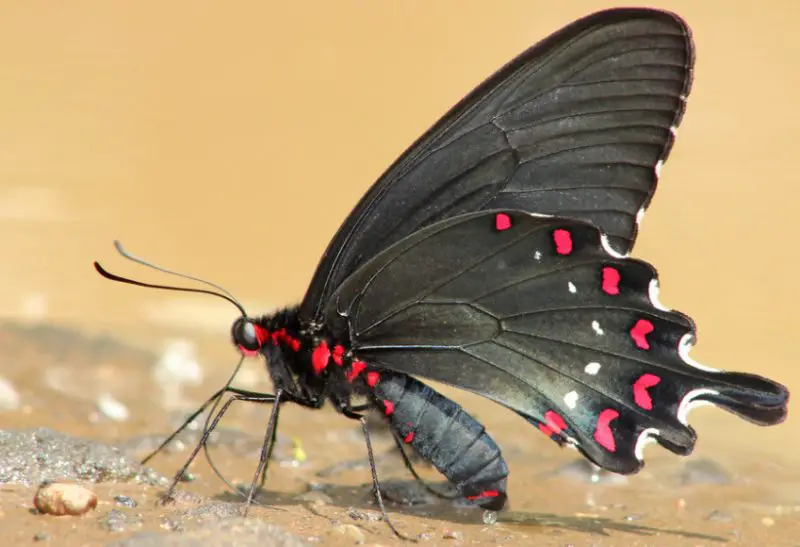
The remarkable pattern of white, pink, and red dots is exhibited by the White-dotted Cattleheart (Parides alopius). The ventral wings and body are highlighted by red spots, while the dorsal wings are decorated with pink and white dots.
They live in pine forests and are mainly found in Central America, though they are also found in Arizona. They fly from May to November.
True Cattleheart
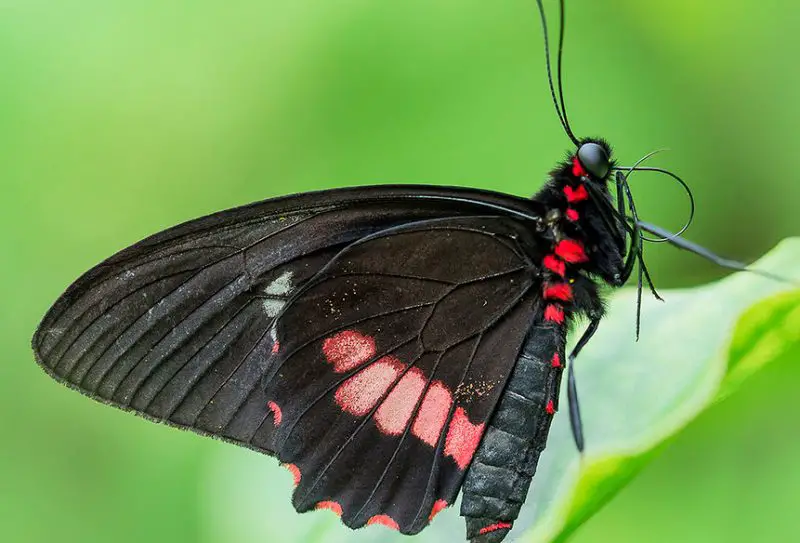
The True Cattleheart (Parides eurimedes) is prevalent across the Americas, boasting a sizable wingspan of up to 3.3 inches. Primarily black, they feature white, red, and pink accents. Distinguishing from the White-dotted Cattleheart, they display red dots on dorsal wings and pink dots on ventral wings, with white sections on the forewings and red sections on the hindwings.
They frequent flowering plants like pelican flowers, which are particularly abundant in South America.
Reddish Mapwing
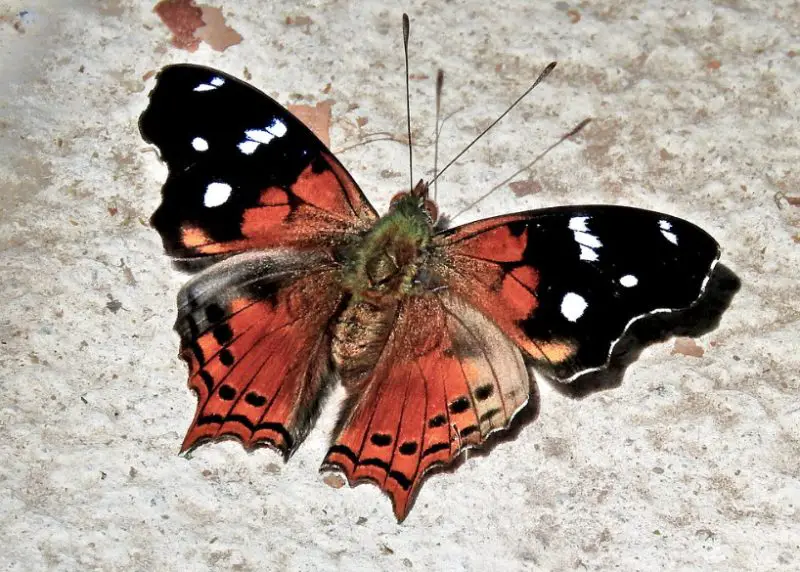
The Reddish Mapwing (Hypanartia trimaculata) is native to Central and South America, showcasing striking red and black hues with yellow and brown variations based on its morph.
Featuring red wings, its forewings display partial black coloring, while the hindwings are entirely red. Black dots adorn the margins, while white dots accentuate the black sections of the forewings. The body is predominantly brown to gray.
Small Flambeau
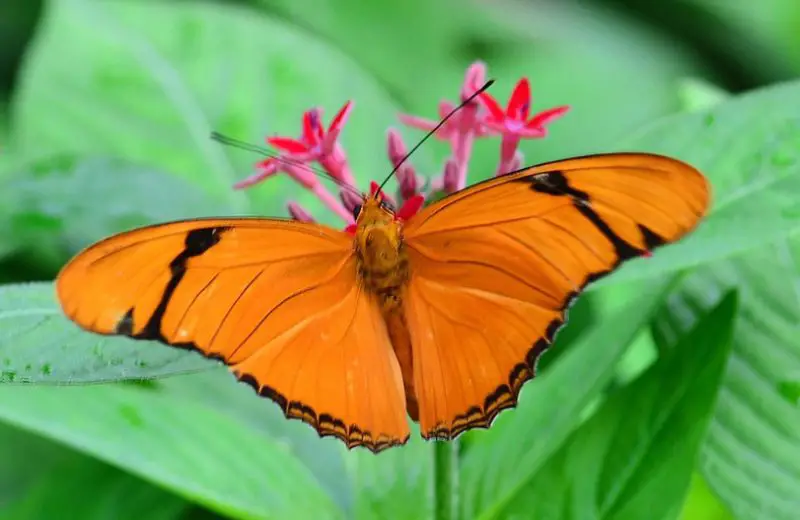
The colorful dorsal wings of the Small Flambeau (Eueides aliphera), which is indigenous to Central and South America, are red and black, while the ventral wings are orange and black. The predominant color is red, with black bars and edges, while the body is mostly orange-brown.
They live at different elevations, sometimes as high as 5,000 feet, and are widespread in Mexico.
Costa-Spotted Beautymark
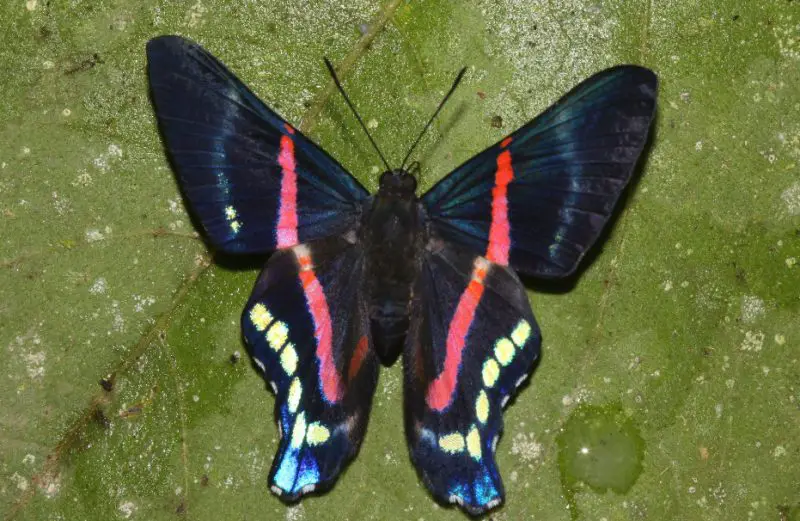
Native to Europe, the Costa-Spotted Beautymark (Ancyluris jurgensenii) displays minor sexual dimorphism. Males have blue coloring on the lower hindwings and margins and black wings with red vertical bars. Females have black wings with modest white markings and red bands instead of blue markings. Wide vertical bars are arranged in black and white patterns on the ventral surfaces.
Flamingo Leafwing

Originating in Central and South America, the Flamingo Leafwing (Fountainea ryphea) is named for its mostly red wings with black edges. There are differences in the red colors; the forewings have a brighter red color, while the hindwings have a deeper shade. They have brown to light brown bodies.
Their preferred habitats are riparian zones, where they may spend the entire day perched on host plants next to rivers and lakes.
Pink-Banded Sister
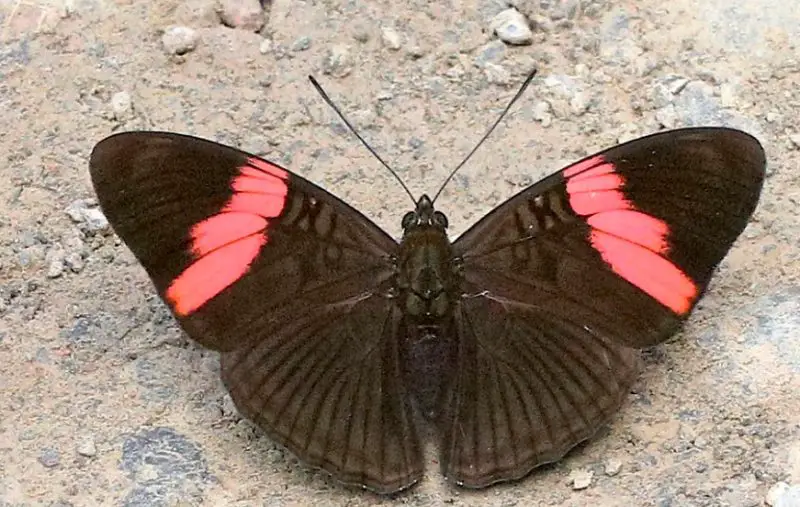
The large pink diagonal bands on the forewings of the Pink-banded Sister (Adelpha lycorias) set it apart from other butterfly species that primarily have black wings. Their wingspan can reach two inches, and they have a maroon ventral coloring.
They can be found in a wide range of settings, from Mexico to Ecuador and Bolivia, and they especially appreciate nettle plants for their caterpillars, such as urera and Jamaican nettle.
Aulestes Doctor
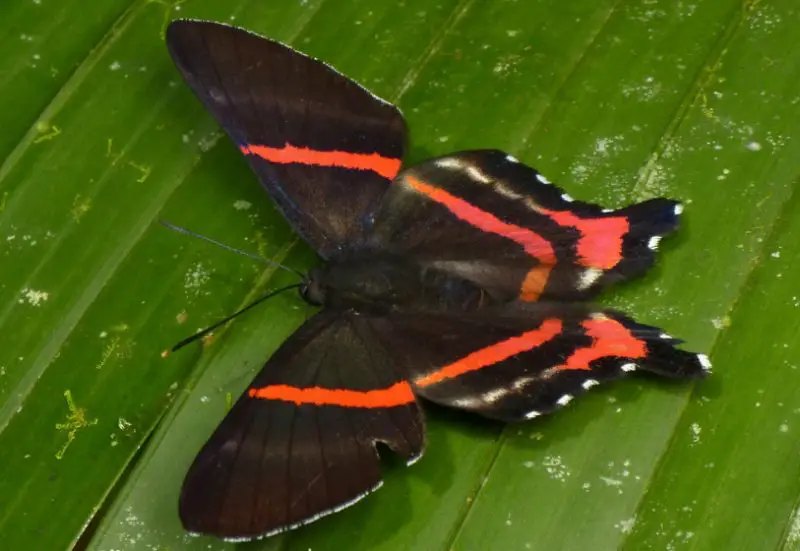
The base color of the Aulestes Doctor (Ancyluris aulestes) varies depending on the gender. It is black in hue overall. Males have forewings with black wings decorated with blue spots and white central lines, and hindwings with double red bands and half-moon-shaped white marks on the edges. The females’ wings are black with orange streaks; they are not blue.
In distinct morphs, diverse color combinations are seen, like red and yellow stripes on the forewings and hindwings. Dorsal hues may be reflected in ventral coloring.
Red-Barred Amarynthis
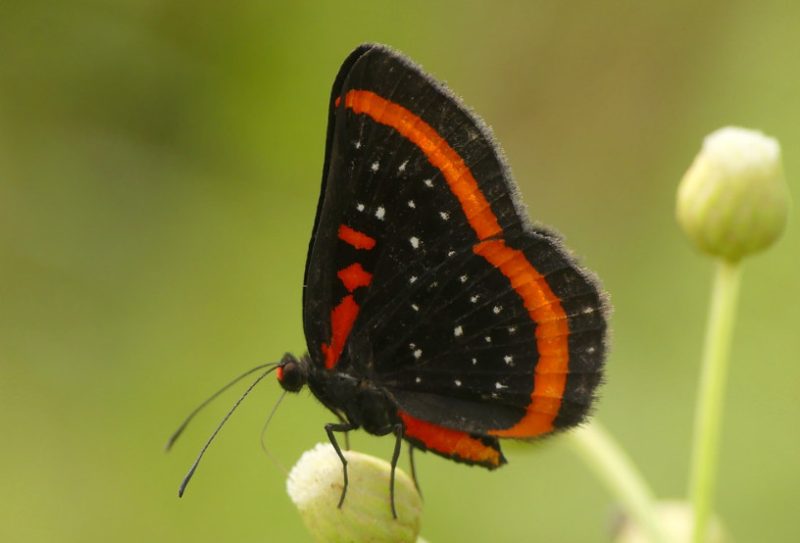
Native to Central and South America, the Red-barred Amarynthis (Amarynthis meneria) lives in lowland rainforests and close to bodies of water. They have mostly black wings with splotchy red markings on the body and red bands around the margins. Unlike red and black butterflies, they also have small white spots resembling celestial bodies, especially on the middle sections of their wings.
They have spread their habitat to include countries like Suriname, which are located east of the Andes in South America.
Red Flasher
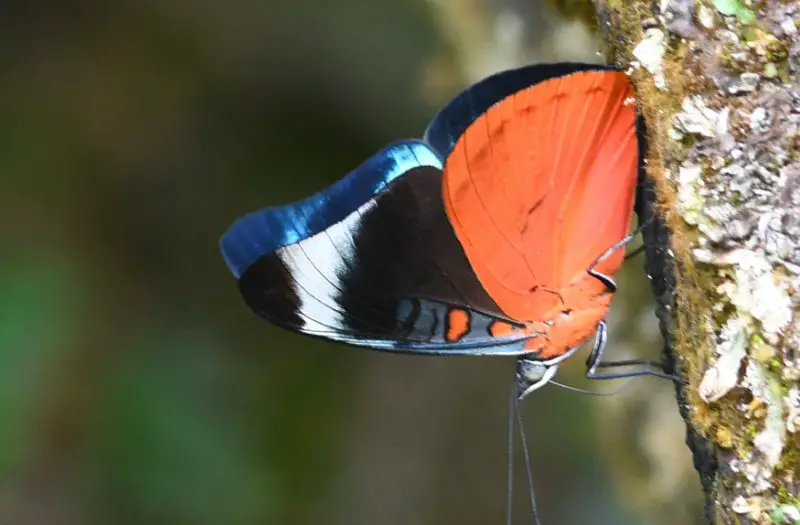
Among the most vibrant black and red butterflies is the Red Flasher (Panacea prola). Their ventral wings are an amazing mix of black, blue, and red, while their predominantly black dorsal wings have subtle blue undertones. Their distinctive bright crimson hindwings are speckled with little black dots.
South and Central America are home to the largest populations, with Peru leading the way.
Cramer’s Mesene
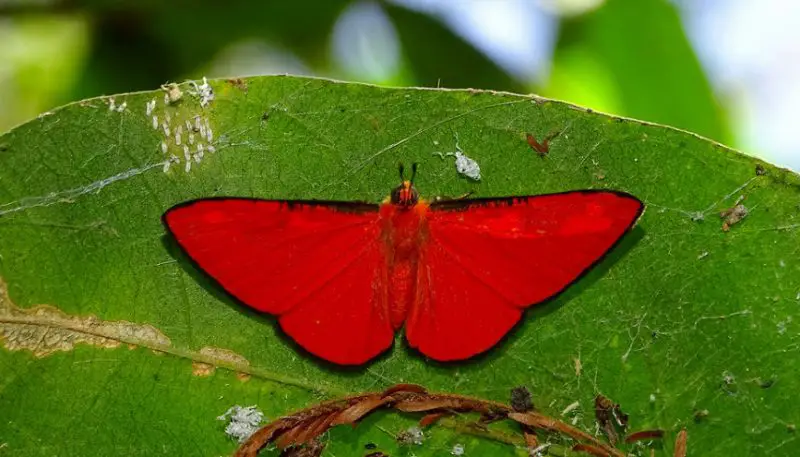
The common red and black Cramer’s Mesene (Mesene phareus) butterfly is found across Central and South America; it is especially prevalent in Suriname. It is distinguished by having a brilliant red base color and broad black edges. Its wingspan can reach up to two inches.
Morph variations include red wings with brown edges or just brown and orange colors.
Redline Doctor
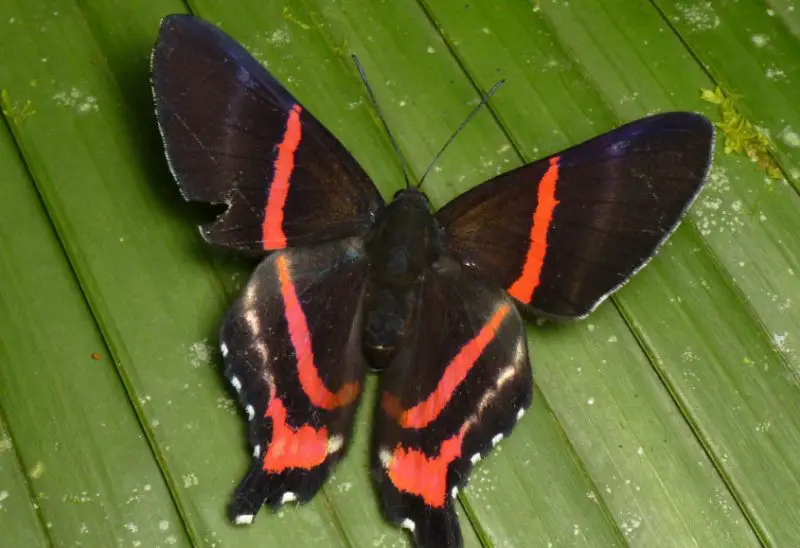
South America is the home of the Redline Doctor (Ancyluris meliboeus), which is primarily black and red in color. They have black forewings and hindwings with red bands on the forewings and double red bands on the hindwings. The lower wing margins have little white spots on them. The ventral wings are colored black, blue, and red; the blue and red areas are more noticeable on the hindwings.
Males puddle to get moisture and nutrients from the mud; they are known for their cannibalistic behavior as larvae.
Fiery Satyr
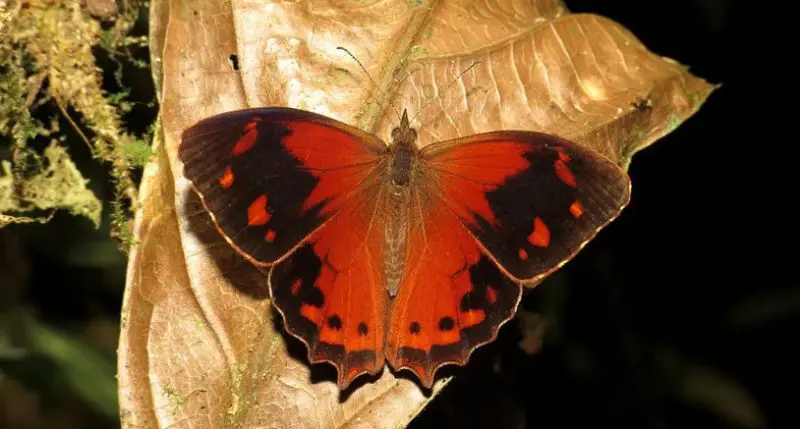
The Fiery Satyr (Lasiophila orbifera) has conspicuous black wing portions to contrast with its orange-red base color. It comes out with brilliant red wings at first, but after a few days, they become orange.
They live in woodlands across South America, including Bolivia and Argentina, and have consistent brown ventral wing hues.
Red-Bordered Pixie
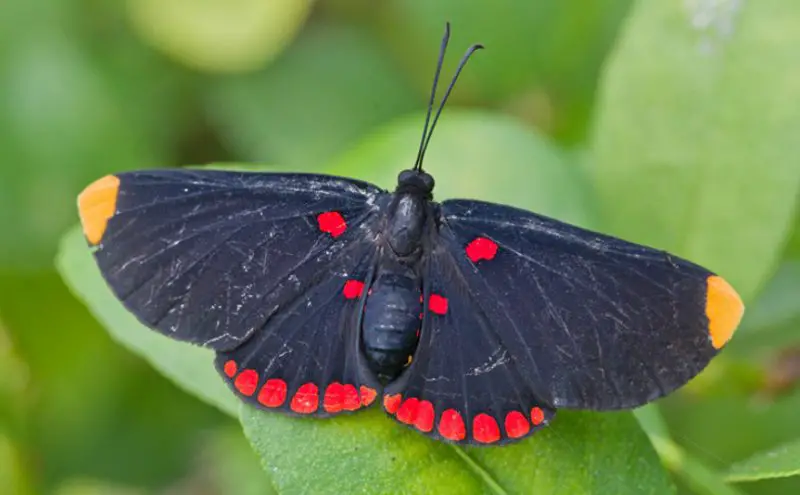
Only found in Southern Texas, the Red-bordered Pixie (Melanis pixe) is distinguished by its black background with vivid red borders and spots on the forewings and hindwings. Its wings have a small wingspan of 1.1 to 1.4 inches with prominent orange margins.
This species, which is active until late autumn, usually favors citrus and blackbeads as host plants.
Snowberry Checkerspot
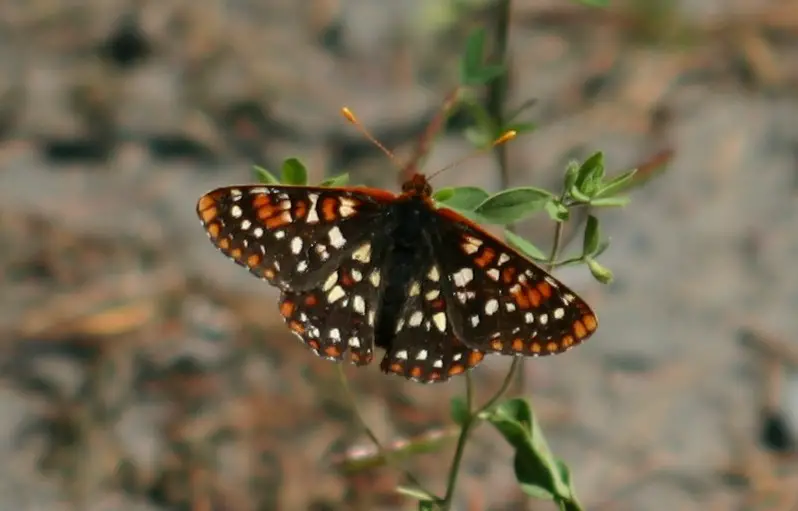
The eye-catching look of Snowberry Checkerspots (Euphydryas colon) is enhanced by bright red dots and edges that contrast with their black basic wing colors. Their forewings have a continuous red border on the top side, and their antennae are colored in shades of yellow-red. There are lots of white spots on the forewings and hindwings of these butterflies.
They like honeysuckle and snowberries as hosts and can be found around water sources and at high elevations.
Ruby-Spotted Swallowtail
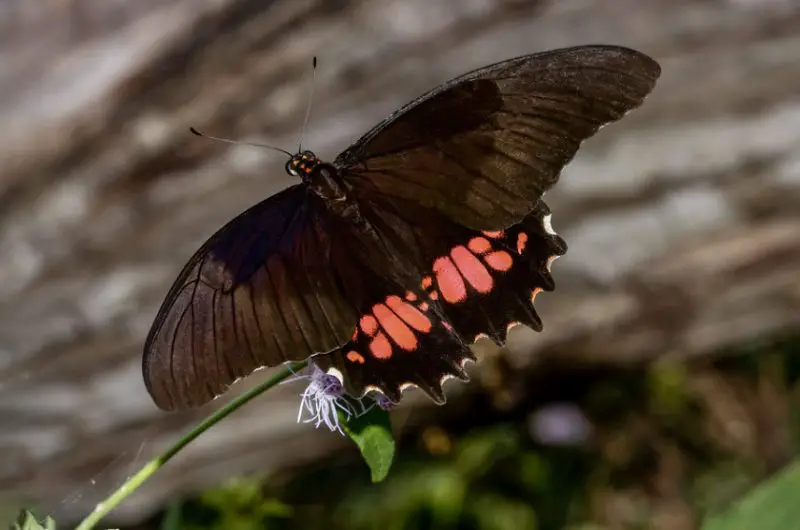
The stunning black and red Ruby-spotted Swallowtail (Papilio anchisiades) butterfly is native to Southern Texas and can be found all the way to Argentina. Its lower hindwings have faded red patches on them, but its wings are mostly black in color. These butterflies, whose wingspan seldom exceeds 2.5 inches, appear in May and are active until October.
They are frequently observed on a variety of citrus plants, which are their preferred host in ecosystems in the South.
Red Postman
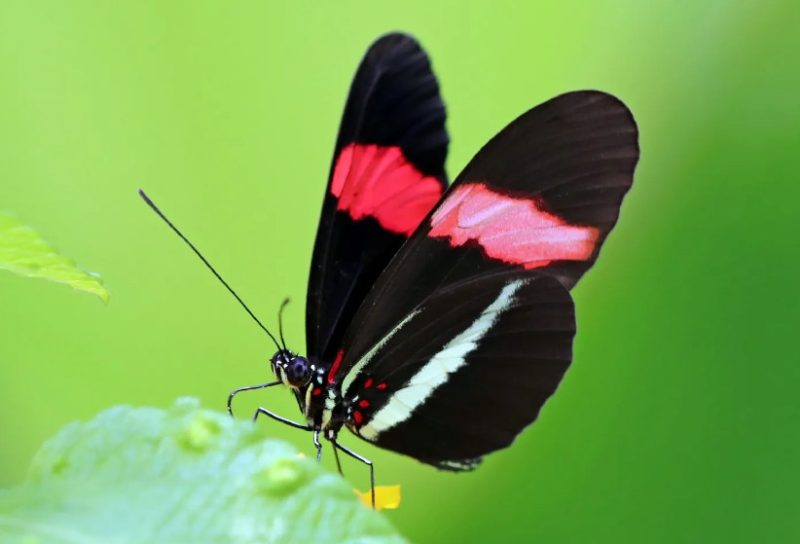
The Red Postman butterfly (Heliconius erato), commonly referred to as the Small Postman, is distinguished by its distinctive black base color with red and white wing parts. Their wings are decorated with two broad red vertical stripes and a white band, and their black bodies have small white spots all over them.
These social butterflies find protection in numbers from raptors like lizards and birds by roosting on host plants like lantana.
Red Rim
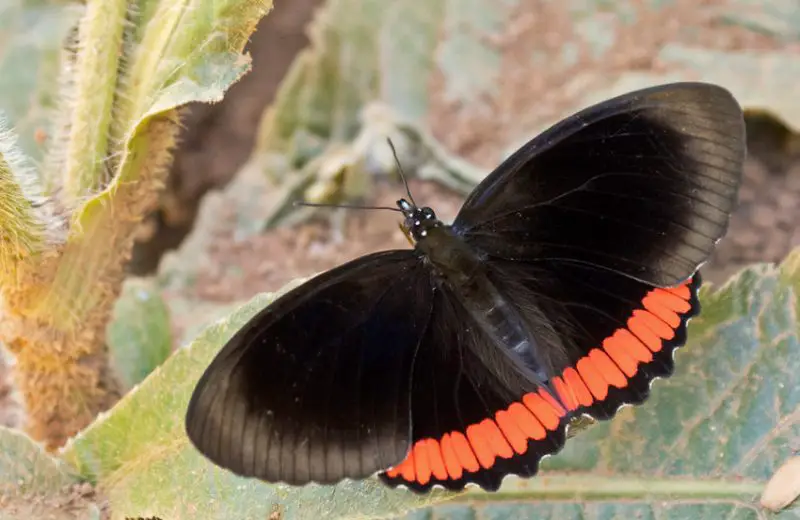
Native to tropical environments, Red Rim butterflies (Biblis hyperia) are primarily found in the southern parts of North America. Their color is mostly black, with minor areas of red and noticeable red stripes on the underside of the hindwings.
They are a persistent and early presence in their environments due to their flying season, which runs from March through October.
Variable Swallowtail
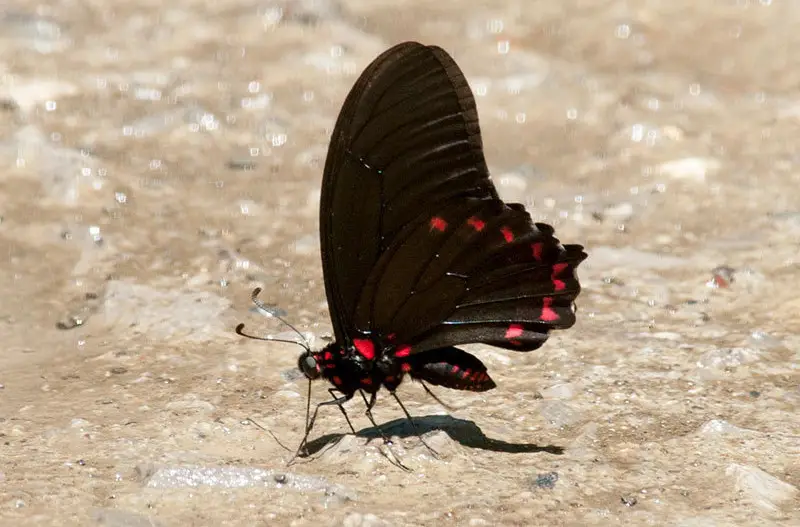
The markings of the Variable Swallowtail (Mimoides phaon) contrast sharply in black, white, and red. Its hindwings and forewings are mostly black, although the edges are speckled with white. The lower hindwings close to the body are decorated with red patterns. Unlike the forewings, the underside of the hindwings has two rows of white patches.
These butterflies are found in tropical areas such as Ecuador and Mexico, where they feed on sugary apples called Annona.
You Might Also Like:



